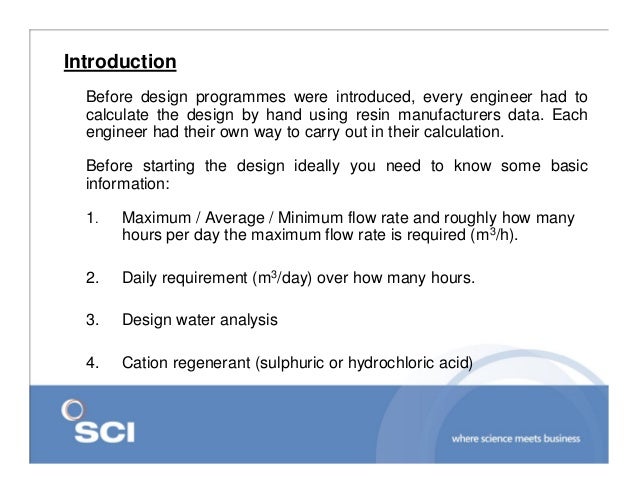- Purolite Ion Exchange Design Calculation Program
- Ion Exchange Design Calculation
- Purolite Ion Exchange Design Calculation Programs 2017
- Purolite Ion Exchange Design Calculation Programs Free

This calculator is under construction. This calculator is based on theoretical calculations and explains how to use selectivity coefficients, separation factors and how to determine the maximum volume of water that can be treated with a resin before breakthrough happens. The calculator also shows some calculations that are needed for the sizing of an ion exchange installation. But again be careful, the calculations are based on theoretical formulas and are not corrected with results from real ion exchange water treatment plants. There is an example under the calculation tables to show how the calculations are made by the calculator. Example calculation to illustrate the equations used by the calculator: The following points are treated in the example:
Lets take water with the following composition:
We want to eliminate anions from the water so we have to use an anionic resin. The resin has a standard exchange capacity of 1,4 eq/L and a density of 0,7 kg/L. In the Literature1 you can find the following values for selectivity coefficients and separation factors (Table 6).
Explanation of the selectivity coefficient and separation factor notation:
The resin has different preferences for the ions in the water. So at equilibrium the ions do not occupy the same amount of resin. The resin prefers much more ions with a high valence. Relation (1) can be written regarding the selectivity of the resin for the different ions in our water sample:
The different separation factors for an ion with respect to the other are calculated with formula (2):
Calculation separation factor for Nitrate NO3- with respect to the 2 other ions using formula (2):
So by putting the write parameters in formula (2) the following separation factors can be calculated for nitrate with respect to the 2 other ions: The calculated separation factors for SO42- with respect to the 2 other ions are: With these separation factors calculated above you can determine the equilibrium capacity of the resin for the different ions.
To control if the result is coherent you can add the equilibrium capacities used by the different ions to see if it is equal to the total exchange capacity of the resin which is 1,4 eq/L.
So you can see that the sum of the equilibrium capacities occupied by the different ions is equal to the total exchange capacity of the resin. Calculation of the maximum volume of water that can be treated per liter of resin before breakthrough occurs:
As you can see from the calculations of Vmax saturation occurs first for Chloride when 60 L of water has been treated. So if you don't want to have chloride in your water you have to stop the ion exchange system or if you have a duplex system you can switch to the other column available and regenerate the column that is saturated with the absorbed ions. If the presence of chloride ions in water in not an issue you can than treat 178 L of water per liter of resin before the breakthrough for Nitrates occurs. Calculation of the percentile repartition of the occupied sites in the resin: Lets calculate the percentile distribution for the different concentrations of ions in our water sample (table 5) As you can see the percentile distribution for concentrations is not the same as the percentile distribution for the occupied sites in the resin at equilibrium. This is due to the fact that the resin is more selective for certain ions. The results for the calculation above are placed in the comparative table 7.
For every different application of water conditioning specific ion exchange resins (Rohm & Haas / Purolite) are available. Lenntech can advise you which is most appropriate. Warning: Lenntech BV cannot be held responsible for errors in the calculation, the program itself or the explanation. For questions or remarks please contact us. |
More from 'Calculators'
Purolite Ion Exchange Design Calculation Program
PureDesign™ is an innovative ion exchange simulation program that helps facilitate design and simulation of ion exchange commonly used in industrial water treatment and industrial water softener system processes. The program provides the means to study all aspects of plant design associated with ion exchange resin performance and operation. The high selectivity for H_C03 is very weakly held on strong-base resins and is always the first ion to break through in column studies [10, 44, 86]. Further, several sources of published, ion-exchange design information [36, 104] state un- equivocally that carbonic acid is not significantly removed by weak-base, anion resins. Interchange of ions between a solid. (ion exchange material) and a liquid. In which there is no permanent. Change in the structure of the solid. Ion exchange is used in water. Treatment and also provides a method. Of separation in many non-water.
Lenntech (European Head Office)

Distributieweg 3
2645 EG Delfgauw
The Netherlands
Phone: +31 152 610 900
fax: +31 152 616 289
e-mail: info@lenntech.com
Ion Exchange Design Calculation
Lenntech USA LLC (America’s)

407 Lincoln Road, Suite 11-C
Miami Beach, FL 33139
Phone: +1 877 453 8095 (speaks English & Spanish)
e-mail: info@lenntech.com
Lenntech DMCC (Middle East)
Level 5 - OFFICE #8-One JLT Tower
Jumeirah Lake Towers
Dubai - U.A.E.
Phone: +971 4 429 5853
e-mail: info@lenntech.com
Purolite Ion Exchange Design Calculation Programs 2017
Purolite Ion Exchange Design Calculation Programs Free
Copyright © 1998-2019 Lenntech B.V. All rights reserved